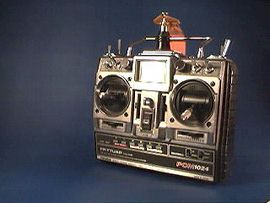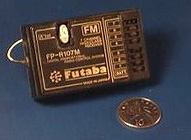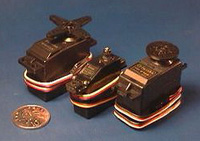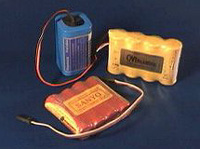

| Getting To Know R/C Radio Systems |

Radios can be grouped into two types, those used for model aircraft and those used for surface models. Although exactly the same electronically and mechanically, they do, by law, operate on different radio frequencies. This is to protect the safety of the modeller and those in the vicinity. A flying aircraft can be dangerous and if radio frequencies were to clash, your model would become uncontrollable, endangering not only you and your aircraft but those around you too. Model Aircraft have been allotted a number of frequencies in the UK within the 35Mhz wave band. Even when operating on these frequencies you still have to be aware that you do not clash with other model fliers around you. A strict control of frequencies is required by each club. They will explain to you their operational procedures. NEVER switch on you R/C system until you have been given the go ahead by your instructor.
Each frequency in our allotted range is given a special 'Channel' number. This is NOT to be confused with channels/functions that each radio can operate. (See 'Getting To Know R/C Model Aircraft).The current range of frequency channels range from Channel 55 to Channel 90. Many clubs in the UK operate a policy of using only 'odd' numbered channels or 'even' numbered channels. It is worth checking this with the club you are joining, before you go out and buy your equipment. For a complete listing of channel numbers and their equivalent frequencies click here.
The first point you should look for when choosing a radio is the number of controls or channels/functions the radio has. (Please note and we can't stress this enough, the term channels in this case refers to the number of controls and does not have anything to do with the frequency on which the radio operates.) Usually modern radio systems are available with anything from 2 to 10 channels.
Radios
For Powered Aircraft
Model
aircraft may require anything up to 10 channels, depending on their complexity.
Most powered Trainer aircraft will generally require at least 3 channels
of control, and possibly 4. One for the rudder, one for the elevator,
one for the ailerons and one for the throttle. Simpler models may omit
the ailerons. More channels/functions are used on advanced and scale models
and may be used for retractable landing gear, operating flaps, bomb drop,
camera actuation, glider release.
Radios
For Gliders
Basic
Trainer gliders usually need only 2 channels, one for rudder and one for
elevator. Additional channels can be used for ailerons, flaps, spoilers,
as your flying skills advance.
Radios
For Helicopters
Starting
your flying career with a model helicopter is really jumping in at the
deep end. We would not recommend it if you have never flown a model before.
However, having said that, it has been done, but please, find yourself
a good instructor. Model helicopters often require a more sophisticated
radio than model aircraft. Helicopter controls are different with more
mixing functions required. Usually a helicopter will operate with a minimum
of 5 channels with the throttle and collective pitch channels both being
controlled by one movement of the throttle control stick.
| What Will You Get With Your Radio System? |
Transmitter
Sometimes referred to as the 'TX'. The transmitter is the hand held control
box that converts your control movements into electrical signals and sends
them via radio waves to the receiver in your model.
 Receiver
Receiver
Sometimes referred to as the 'RX'. The receiver is the small electronic
box the size of a matchbox and placed in your model. The receiver converts
the signal from your transmitter into electrical control signals which
can be sent to your servos.
Servos
Servos are the devices in the model which actually produce the control
movements. Servos convert the electrical signals from your receiver into
physical movement to control your model. A different servo is needed for
each control function or radio channel.
 Batteries
Batteries
Virtually all 4 channel systems come complete with NiCad rechargeable
battery packs (a pack for the transmitter and a pack for the airbourne
receiver and servos) and charger that will recharge both packs. You should
NEVER use Alkaline batteries in any R/C model aircraft.
Radio Modulation
When looking for a radio, you will find that people often speak about
different types of modulation. They are referring to the way the electronic
control information is sent from your transmitter to the receiver over
radio waves.
AM
Amplitude Modulation, was the first means of modulation in R/C. The control
information is transmitted by varying the amplitude of the signal. This
form of modulation has, in R/C aircraft been superseded by FM.
FM
Frequency Modulation, is now the usual method of transmitting the radio
signal. It is less prone to interference than AM. It is transmitted by
varying the frequency of the signal.
PCM
Pulse Code Modulation, FM is still used, but the control information is
in the form of a digital signal rather than the pulse width used in AM
or FM. Using PCM adds additional safety and is very much less prone to
interference.